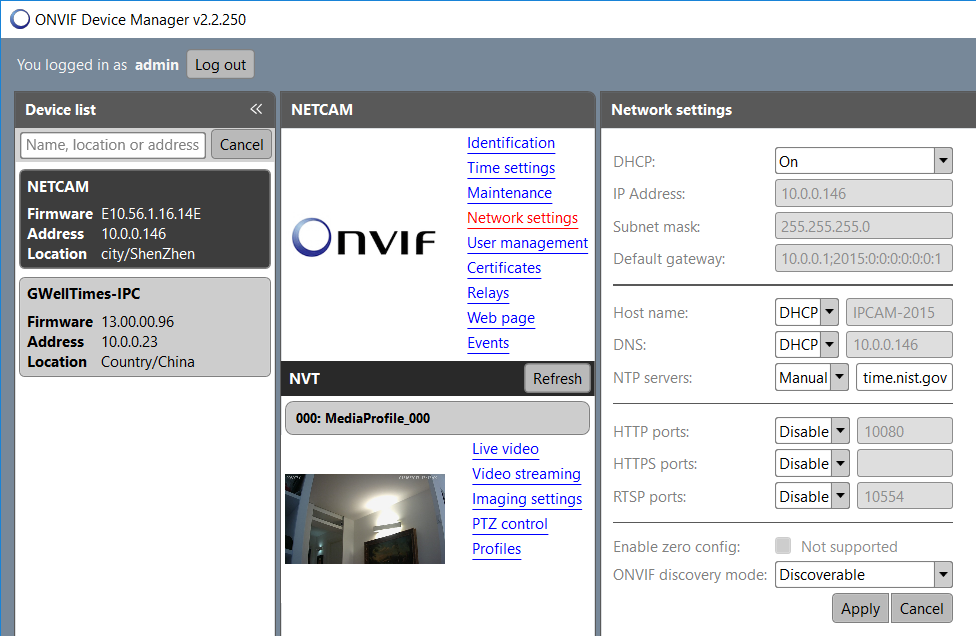
- SECURITYSPY RTSP UPDATE
- SECURITYSPY RTSP UPGRADE
For each Preset defined in SecuritySpy, a button will be created to activate that preset.ĬHANGED: Removed the online attribute from the Camera Entity, as this is now replaced with the Binary Online sensor.ĬHANGED: All entities have been updated to follow a more up to date coding practice for Home Assistant Integrations.įIXED: Ensuring the Websocket is properly closed before a restart of the Integration.įIXED: Deprecation warning about device_state_attributes start showing up in Home Assistant 2021.12. When pressing this button the camera will stop any movement currently in progress. When pressing this button the camera will start a downwardst movement. When pressing this button the camera will start an upwards movement.

When pressing this button the camera will start a right movement. When pressing this button the camera will start a left movement. If a camera has PTZ capabilities, the following buttons will be created: NEW: Added configuration url for each camera on the Devices page, so that you can go directly from here to the Camera Settings page in SecuritySpy
SECURITYSPY RTSP UPDATE
This sensor is event driven, so as soon as SecuritySpy flags it as Offline the sensor will update and vice versa. NEW: Added a new Binary Sensor for each Camera showing if the Camera is updated.
While still on this page, click the + ADD INTEGRATION button in the lower right corner, search for SecuritySpy, and start the installation, supplying your credentials. Remove the SecuritySpy Integration by going to the Integrations page, click the 3 dots in the lower right corner of the SecuritySpy Integration and select Delete. SECURITYSPY RTSP UPGRADE
Upgrade the Integration files, either through HACS (Recommended) or by copying the files manually to your custom_components/securityspy directory. Upgrade Instructionsĭue to the many changes and entities that have been removed and replaced, we recommend the following process to upgrade from an earlier Beta or from an earlier release: However I would be more inclined to purchase battery cameras if I knew that they were still recording even when power/internet was down and that I would have access to the video once power/interenet was restored.This release contains BREAKING CHANGES and you will have to re-define most of your settings in the UI and in automations after installation. Most of the cameras I have are wired because because at the time I bought them, my logic was that if I don’t have power, then I don’t have internet so the battery cameras would serve no additional benefit with the added con that I have to worry about changing and charging batteries. But it seems like an easy addition that Ring could easily implement would be have a small amount of internal storage so that as long as the cameras have power, they could continue recording when they detect motion as they normally would, and then when internet connection is restored the video could be uploaded. Now I know if the internet is out there is no way to possibly have a live feed option. I tried getting on and looking at the cameras and, of course, there wasn’t anything because the internet was out. During that time, however, my wife called and said that the Spectrum guy was in our front yard doing some really weird stuff which made her a little uncomfortable. It this case it was a neighbor having something worked on, and they had to reset the internet for just a couple of minutes. Our power rarely ever goes out, even during really bad storms or snows, so usually if the internet goes out it’s because of some construction in the neighborhood. So yesterday our internet went out for a short period of time. Possible throttling bandwidth if setup with modes or only sending motion to ring.Ĭoding could also happen locally, creating less of an impact on ring servers. Less client downtime, when ring has outages, means more client satisfaction. Using locally stored video, has less backhual/work for ring servers. Less impact on bandwidth when motion is detected or when reviewing the last 1tb of videos. 

No more latency issues causing sound and video issues. It will make ring work faster at homes and businesses. Eventually all data would still be uploaded. For example, my out door cams could upload to both right away, but my indoor cams only upload to ring depending on my alarm mode or time of day. The device would still upload to ring, just in a different way. The device would also cache 1tb of videos so my app could play them with speed when there is bandwidth issues. The device cache my video when my internet is down or my internet is slow. I want to be able to buy a local storage device. also the ring app needs to be able to view from the dvr, before going to ring servers. My area is seeing bandwidth issues, with everyone staying at home… I want a local DVR that uploads to ring after it does it work, setup with modes, or different cams upload in different ways.







 0 kommentar(er)
0 kommentar(er)
